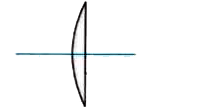The focal length of a plano-convex lens is f and its refractive index is 1.5 it is kept over a plane galss plate with its curved surface touching the glass plate. The gap between the lens and the glass plate is filled by a liquid. As a result the effective focal length of the combination becomes 2f. Then the refractive index of the liquid is
1.5
2
1.25
1.33
The correct Answer is:C
To find the refractive index of the liquid that fills the gap between the plano-convex lens and the glass plate, we can follow these steps:
Step 1: Understand the Setup
We have a plano-convex lens with focal length f and refractive index μ=1.5. The lens is placed on a plane glass plate, and the gap between the lens and the glass plate is filled with a liquid. The effective focal length of the combination becomes 2f.
Step 2: Write the Formula for Effective Focal Length
The formula for the effective focal length F of two lenses in contact is given by:
1F=1f1+1f2
where f1 is the focal length of the plano-convex lens and f2 is the focal length of the liquid layer acting as a lens.
Step 3: Identify the Focal Lengths
For the plano-convex lens:
- f1=f
For the liquid layer, which behaves as a plano-concave lens:
- Let the focal length of the liquid be f2.
The effective focal length of the combination is given as 2f:
12f=1f+1f2
Step 4: Rearranging the Equation
Rearranging the above equation gives:
1f2=12f−1f
Finding a common denominator:
1f2=1−22f=−12f
Thus,
f2=−2f
Step 5: Use the Lensmaker's Formula for the Liquid
The lensmaker's formula is given by:
1f=(μ−1)(1R1−1R2)
For the liquid layer:
- The radius of curvature R1=−r (for the curved surface of the lens),
- The radius of curvature R2=∞ (for the flat surface of the glass plate).
Thus, the formula for the liquid becomes:
1f2=(μliquid−1)(1−r−0)
Substituting f2=−2f:
−12f=(μliquid−1)(−1r)
Step 6: Relate the Focal Lengths
Now, for the plano-convex lens:
1f=(1.5−1)(1r−0)=0.5r
Thus, r=0.5f.
Step 7: Substitute r into the Liquid Equation
Substituting r into the equation for the liquid:
−12f=(μliquid−1)(−10.5f)
This simplifies to:
−12f=−2(μliquid−1)1f
Cancelling −1f from both sides gives:
12=2(μliquid−1)
Thus,
μliquid−1=14
So,
μliquid=1+14=1.25
Conclusion
The refractive index of the liquid is μliquid=1.25.
We have a plano-convex lens with focal length f and refractive index μ=1.5. The lens is placed on a plane glass plate, and the gap between the lens and the glass plate is filled with a liquid. The effective focal length of the combination becomes 2f.
The formula for the effective focal length F of two lenses in contact is given by:
1F=1f1+1f2
where f1 is the focal length of the plano-convex lens and f2 is the focal length of the liquid layer acting as a lens.
For the plano-convex lens:
- f1=f
- Let the focal length of the liquid be f2.
12f=1f+1f2
Rearranging the above equation gives:
1f2=12f−1f
Finding a common denominator:
1f2=1−22f=−12f
Thus,
f2=−2f
The lensmaker's formula is given by:
1f=(μ−1)(1R1−1R2)
For the liquid layer:
- The radius of curvature R1=−r (for the curved surface of the lens),
- The radius of curvature R2=∞ (for the flat surface of the glass plate).
1f2=(μliquid−1)(1−r−0)
Substituting f2=−2f:
−12f=(μliquid−1)(−1r)
Now, for the plano-convex lens:
1f=(1.5−1)(1r−0)=0.5r
Thus, r=0.5f.
Substituting r into the equation for the liquid:
−12f=(μliquid−1)(−10.5f)
This simplifies to:
−12f=−2(μliquid−1)1f
Cancelling −1f from both sides gives:
12=2(μliquid−1)
Thus,
μliquid−1=14
So,
μliquid=1+14=1.25
The refractive index of the liquid is μliquid=1.25.
Topper's Solved these Questions
- BOOK - CP SINGHCHAPTER - REFRACTION AT SPHERICAL SURFACESEXERCISE - EXERCISES105videos
REFRACTION AT SPHERICAL SURFACES
- BOOK - CP SINGHCHAPTER - REFLECTION OF LIGHTEXERCISE - EXERCISES67videos
REFLECTION OF LIGHT
- BOOK - CP SINGHCHAPTER - REFRACTION OF LIGHT BY PLANE SURFACESEXERCISE - Exercises110videos
REFRACTION OF LIGHT BY PLANE SURFACES
Similar Questions
Knowledge Check
- Question 1 - Select One
A plano-convex lens is made of refractive index of 1.6. The focal length of the lens is
A400 cmB200 cmC100 cmD50 cm - Question 2 - Select One
A plano-convex lens is made of glass of refractive index 1.5. the radius of curvature of its convex surface is R. its focal length is
AR2BRC2RD1.5R - Question 3 - Select One
Find the focal length of plano-convex lens of material having refractive index of 1.5. Radius of curvature of convex surface is 10 cm.
 A20 cmB30cmC50 cmD40 cm
A20 cmB30cmC50 cmD40 cm
The focal length of a glass lens in air is f. When immersed in water (refractive index μ) its focal length would be
View SolutionThe radius of curvature of the face of plano-convex lens is 12cm and its refractive index is 1.5. If the plane surface of the lens is now silvered, then find the focal length of the lens.
View SolutionA plano-convex lens is made of glass of refractive index 1.6. the radius of curvature of its curved surface is 30 cm. What is the focal length of the lens ?
View SolutionThe focal length of a plano-convex lens is equal to its radius of curvature. The value of the refractive index of its material is
View SolutionA plano-convex lens is made of refractive index 1.6. The radius of curvature of the curved surface is 60 cm. The focal length of the lens is
View Solution

